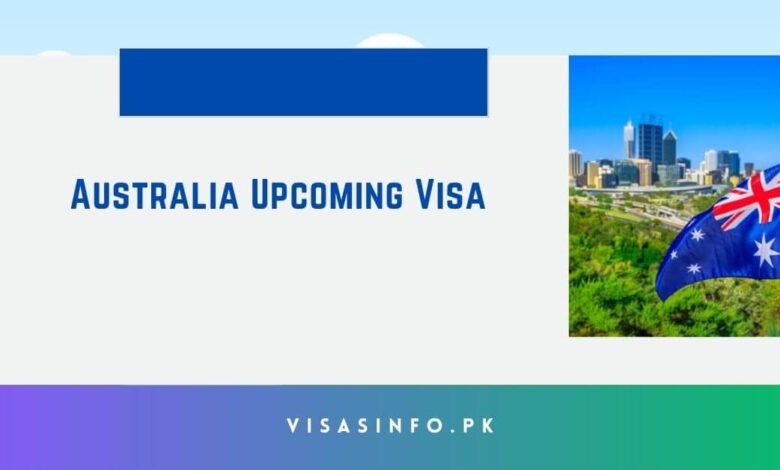Australia Upcoming Visa Changes for 2024

Australia is an intriguing country that draws individuals seeking new opportunities for career advancement and personal growth as a result of its stunning landscapes and thriving economy. To preserve its appeal to skilled migrants, the Australian government intends to implement substantial modifications to visa restrictions in 2024.
The objectives of these meticulously crafted modifications to Australia’s immigration calendar for 2024 are to enhance the backgrounds and skill sets of newcomers, simplify the visa application process, and address labor shortages in specific sectors of the economy. Both current and prospective applicants must be cognizant of the implications of these modifications to the visa regulations.
These modifications illustrate Australia’s newfound leniency toward job seekers and indicate a shift in the government’s stance on qualified labor. The subsequent reforms are essential for individuals who aspire to relocate to Australia.
1. Expansion of Regional Visa Options
The government’s commitment to reducing labor shortages in rural areas and promoting balanced population growth is highlighted by the establishment of Regional Visa Alternatives, a significant development. Several visa categories, such as the Skilled Independent Visa (Subclass 189), Employer-Sponsored Skilled Visas (Subclasses 186 and 190), Business Innovation and Investment Visas (Subclasses 188, 888, and 132), and Global Talent Visa (Subclass 858), are impacted by these legislative amendments.
Additionally, changes are being implemented to Subclass 417 and Subclass 462 of the work and vacation visas. This exhaustive plan aims to simplify the visa application process by reducing the number of required forms and implementing more user-friendly online platforms. Prospective employees will shortly find it easier to apply for visas through the Streamline process.
2. Simplified PR Pathways
Another substantial change is the simplification of the application procedure for permanent status for temporary visa holders. The objective of this modification is to enhance the stability and confidence of workers, as they are a significant contributor to Australia’s economic prosperity. The government is endeavoring to create a hospitable environment for individuals who are essential to the nation’s future by facilitating permanent relocation.
This ruling, which is anticipated to be implemented in the latter half of 2024, offers temporary visa holders a more direct route to permanent residency, which is a promising development. It provides a sense of security and validates the contributions these individuals have made to Australia’s economic advancement.
Potential employees have the opportunity to benefit significantly as these visa reforms are implemented. The expedited application process is expected to lead to a more efficient process and a greater likelihood of employment in high-demand disciplines. The opportunities for permanent residency provide a sense of permanence and encouragement to those who are making significant contributions to Australia’s success story.
3. Regional PR Visa Possibilities
This project, which is anticipated to be completed in the first half of 2024, will contribute to Australia’s economic requirements and expand its labor force, thereby preparing the nation for robust development. The migration environment of Australia is transforming; however, this process will not occur immediately. Rather, it will transpire in 2024.
The government is gradually increasing the number of Regional PR Visa opportunities to attract talented individuals to rural areas. This intentional action is intended to address the local labor shortage and promote a more equitable population distribution. The administration has initiated the process of applying these extensions to regional visas. A phased deployment is still expected to occur in 2024.
The ultimate goal is to create an environment in which highly qualified individuals are motivated by incentives to contribute to the growth of local communities, thereby facilitating a more equitable distribution of talent throughout the nation.
The 2024 Visa program modifications implemented by Australia are a positive initial step toward the establishment of a more outcome-oriented and adaptable immigration system. They continue to be driven by the objective of economic advancement and their commitment to regional development, and they are committed to attracting and retaining qualified individuals who can advance the nation.
Check Also: Australia 189 Visa Invitation Round – Visit Here
Benefits of Australia Upcoming Visa Changes
- Streamlined Processing: Employers will be able to more easily fill critical roles by reducing delays for skilled migrants through the expedited approval of visas.
- Targeted Occupations: The upcoming changes will concentrate on in-demand sectors, including healthcare, engineering, and IT, providing additional opportunities for qualified professionals.
- Extended Stay for Temporary Visas: Certain temporary visa holders, particularly graduates and skilled workers, will be granted the opportunity to extend their stay, which will provide them with additional time to pursue employment and potentially secure permanent residency.
- Simplified Pathways to PR: The transition from temporary to permanent residency is intended to be facilitated by specific visa reforms, such as the expansion of eligibility for the 189 Visa or regional migration schemes.
- Enhanced Points for Skilled Migration: The points-based system will be advantageous to individuals who possess advanced qualifications, work experience, and English proficiency.
- Inclusion of Additional Family Members: The implementation of reforms may facilitate the reunification of families, providing them with the opportunity to join skilled migrants in Australia.
- Regional Migration Enhancement: The upcoming changes will continue to encourage skilled workers to relocate to rural or regional areas, thereby balancing population growth by offering additional incentives.
Australia Graduate Work Visa: 4-Year Work Visa
What courses are eligible for a work permit for graduates? Students frequently inquire whether their coursework will qualify them for a Graduate Work Visa (Subclass 485), which is also referred to as a TR. In this update, we will be evaluating courses that may be of assistance in obtaining a graduate work visa.
A graduate work visa enables an applicant to reside in the country for a period of two to six years after completing their studies. During this period, a significant number of these applicants will acquire additional work experience to meet the requirements for permanent residence. Nevertheless, to obtain this study visa, it is necessary to enlist in a pertinent course. It is important to note that to be eligible for any of the programs, you must have completed 92 weeks of study at the Commonwealth Register of Institutions and Courses for Overseas Students (CRICOS), which is nearly two years.
The graduate stream and the post-study employment stream are two distinct streams. It is imperative to bear in mind, however, that a Bachelor’s, Master’s, or Doctoral degree would typically qualify an individual for a Post-Work stream. Nevertheless, enrollment in certain vocational courses will qualify you for the graduate stream.
Eligibility Requirements
To be eligible for the Graduate stream, you must:
- Select any career path from the list of medium- and long-term strategic competencies. A bachelor’s degree is not required for the professions of trades, telecommunications, and civil or electrical drafting, which are included in the medium- and long-term strategic skills list.
- A degree or diploma in a trade that is directly pertinent to the position is required. The labor you aspire to complete should be closely related to the field of study you have selected. For instance, to pursue a vocation as a carpenter, it is necessary to have completed a comparable course of study. Certificates or credentials in building and construction may be obtained through the completion of supplementary pertinent courses. Consequently, you may not have considered carpentry to be a particularly pertinent field if your qualifications included a diploma and an advanced diploma in management.
- An initial skill exam administered by an authorized assessing authority should be passed to demonstrate that you possess the requisite skills for your chosen occupation.
- A preliminary assessment of proficiency. You must complete a preliminary skill assessment or skill assessment. For example, upon completion of a certificate program in commercial cuisine, it is possible to apply for a provisional competence evaluation as a chef.
Nevertheless, you may be unable to pass the requisite skill assessments to secure employment as an engineer if you pursue an engineering diploma. On the other hand, if you have previously studied in your country of origin and can pass a competency exam based on this study, you will be exempt from all of these criteria. For instance, you may have earned a Bachelor of Civil Engineering degree in your country. With this, you should be able to complete a talent exam and consider obtaining a project management diploma as a compulsory component of your education.
Frequently Asked Questions:
-
What are the new visa changes in Australia?
Changes to work-related visa conditions
Current and future holders of 482, 457, and 494 visas who cease employment with their sponsoring employer now have up to 180 consecutive days, with a maximum of 365 days in total across the visa grant period, to find a new sponsor, apply for a different visa, or depart Australia. -
What is the new visa policy in Australia?
In the 2024–25 Budget, the government announced plans to introduce a pre-application ballot process for certain kinds of visas: work and holiday visas for nationals of China, Vietnam, and India, and a new temporary visa for young professionals from India. The ballot process is new to the Australian visa system.
-
What is the minimum balance for an Australia visa?
Passports should include visa stickers and entry-exit stamp pages. For an Australia Tourist Visa, a minimum bank balance of AUD 5000 (INR 3,50,000) is required. Also, recommend having this balance consistently for 3 to 6 months.



